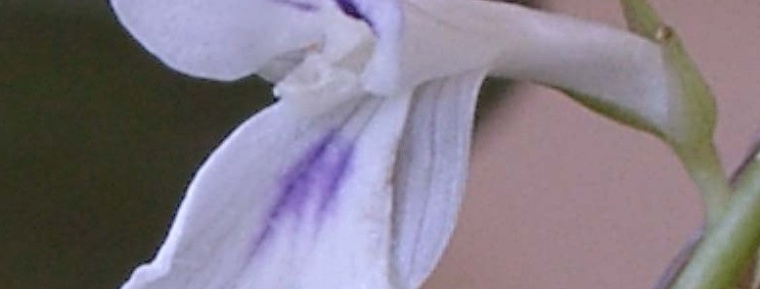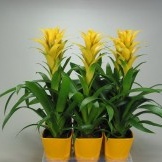Maranta: from hot Brazil to your windowsill
Fans of landscaping apartments and offices already know everything about the arrowroot family. Each collector of domestic plants considers his collection incomplete without representatives of this genus.
General plant information
In the genus Moraine, there are more than 25 species. Arrowheads belong to deciduous plants, reaching a height of 30 cm. They are great for decorating rooms. Attractive appearance is provided by leaves, on which a bright painting of veins is visible.
The leaves of the plant are oval. Their length reaches 15 cm. A bright strip and two rows of spots of brown or lighter colors are located along the central vein. The leaf itself can be from dark green to light green.
On the other hand, the sheet may be red or blue. On the stems are rosettes, and the leaves are directed upwards (in young plants). The arrowroot blossoms softly. Inflorescences look like ears of corn or panicles.
Interestingly, the arrowroot behaves in the dark. Its leaves rise up and close to the outlet. Getting into the rays of light, they fall into a horizontal position and open the outlet. For this, the arrowroot received the second name "prayer plant"
There are several types of this plant that are suitable for growing at home:
- white-veined (leuconeura);
- kerchoveana;
- massangeana;
- tricolor;
Humidity and watering arrowroot
The disadvantage of arrowroot is its sensitivity to soil and air humidity. There should be enough water, but excessive watering can kill a flower very quickly. When spraying, it should be remembered that the droplets remaining on the leaves can dry, leaving unaesthetic spots behind. Therefore, spraying should be shallow. In order to avoid stains, you need to wipe the leaves with a moistened cloth.
The plant will be comfortable with a water tray (sphagnum or wet peat can be used), in which the pot is placed. This will create the necessary microclimate inside and around the pot. Ideal for irrigation will be a liquid at room temperature. It’s better to be soft.
In summer, you can increase the volume of water being poured. In winter, this is no longer necessary. In any case, the soil should always be moderately moist.
Temperature and plant lighting
In order for the arrowroot to feel comfortable, it is necessary to maintain a balance of light and shadow. The best option would be diffused light. With an excess of sunlight, arrowroot leaves tend to change color and not reach the maximum values in size.
Artificial lighting is also acceptable for growing arrowroot. But the plant can be under its influence no more than 16 hours a day.
The temperature in the room should be maintained at the right level, since the arrowroot is very thermophilic. Usually room temperature in the region of 22-25 grams is the most suitable.
Overheating should be avoided, as this is detrimental to the flower. The most difficult condition to observe in the summer. The soil must also comply with the standards. The thermometer should show no more than 18 gr. During the dormant period from October to February, maintaining the soil temperature in the range of 18-20 grams is especially important. The minimum limit of soil temperature during this period is 10 g.
The most dangerous for arrowroot will be sudden changes in temperature and drafts. The plant must be protected from such conditions.
In winter, the plant should not be placed close to window panes. Excessively bright lighting or, conversely, when it is lacking, the leaves lose their brightness.
Reproduction of arrowroot in the conditions of the apartment
Plant transplantation should be carried out annually or every two years in the spring.For this, loose soil is used, which consists of two or three parts of a leaf mixture, one part of peat, one part of humus and another one of coniferous soil mixed with sand. It’s good to add some charcoal to this mixture.
There should be absolutely no lime in the soil. Maranta is not able to grow in such conditions. At the bottom of a wide but shallow pot you need to put a layer of expanded clay for good drainage. Features of the dishes are dictated by the horizontal development of the rhizome, which should be covered with wet moss.
When transplanting a new pot should be only a couple of centimeters in diameter larger than the previous one. The transplanted flower must be carefully transferred to a new pot, keeping a lump of earth around the rhizome. Free space must be filled with fresh mixture.
Professionals in this field recommend cutting new internodes from the root before transplantation, leaving only one. Then the plant will be more magnificent and green.
The main methods of reproduction are dividing in spring, which is used more often, or by vertex cuttings, which is rarely used.
When transplanting, you need to divide the lump into two or three parts so that each contains two or three good shoots and several leaves. Until the new plants are fixed, the pots are covered with polyethylene and kept in a warm place.
Using the cuttings method, you can place them directly in the ground and cover with polyethylene. A glass jar or a plastic bottle is suitable. As an alternative, you can use a vessel with water where the cuttings are placed.
Given that the arrowroot doesn’t take root in apartment conditions, you need to use several cropped cuttings at once to increase the chances of getting a full plant.
If the plant has lost its appearance and faded, then it can be cut directly under the root. Make it better closer to winter. Such a trimmed bush is best placed in a dark place and watered from time to time.
According to statistics, after this procedure, the new bush will be richer and brighter. Leaves will be larger with a pronounced pattern.
A plant such as arrowroot looks very organically in the interior. In addition, it tolerates proximity to other colors. Having mastered all the rules of plant care, you can get amazingly beautiful decoration in the room.























































